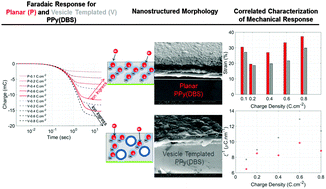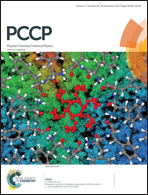Mechanoelectrochemistry of PPy(DBS) from correlated characterization of electrochemical response and extensional strain†
Abstract
This paper investigates nanostructured morphology-dependent charge storage and coupled mechanical strain of polypyrrole membranes doped with dodecylbenzenesulfonate (PPy(DBS)). Nanoscale features introduced in PPy(DBS) using phospholipid vesicles as soft-templates create a uniform and long-range order to the polymer morphology, and lead to higher specific capacitance. It is widely stated that nanostructured architecture offer reduced mechanical loading at higher charge capacities, but metrics and methods to precisely quantify coupled localized strains do not exist. Towards this goal, we demonstrate the use of scanning electrochemical microscope with shear force imaging hardware (SECM-SF) to precisely measure charge storage function and volumetric strain simultaneously, and define two metrics – filling efficiency and chemomechanical coupling coefficient to compare nanostructured morphologies and thicknesses. For thin membranes (smaller charge densities), planar and vesicle-templated membranes have comparable mechanoelectrochemical response. For thick membranes (0.4 to 0.8 C cm−2), a 15% increase in charge storage is associated with 50% reduction in extensional strain. These results allow for the formulation of rules to design nanostructured PPy(DBS)-based actuators and energy storage devices.



 Please wait while we load your content...
Please wait while we load your content...